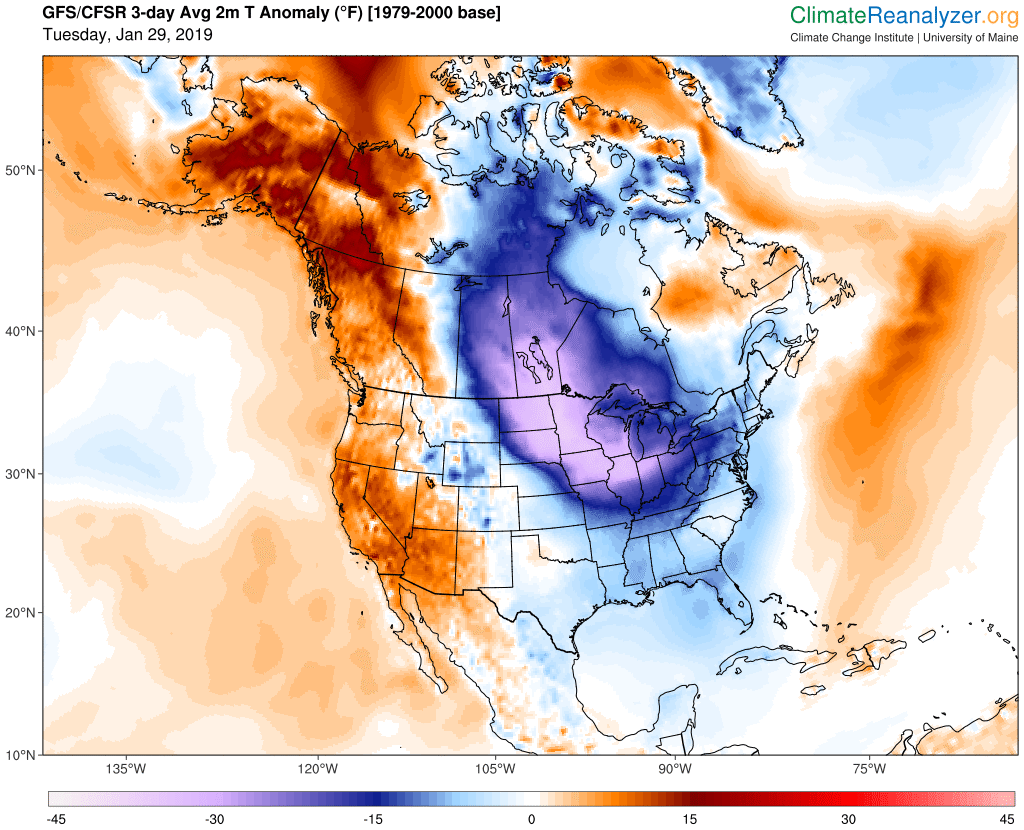Brutal Honesty about Electric Heat in the Brutal Cold
In extreme cold, electric heat is far more expensive than fossil fuel. But over the full heating season, we can still come out ahead with 100% clean electricity.

Minnesota is currently in the grip of the “polar vortex”. The projected high temperature in Minneapolis tomorrow is -14° (!), the low temperature is a preposterous -31°, and I can’t even bring myself to type out the projected wind chills. It’s the coldest weather we’ve seen in decades.
So how does the 2040 Energy system perform in this weather?
First, though: Is This the End of Global Warming?
Before I dig into the nitty gritty of heating effiency, I feel compelled to share a few facts about how this cold snap relates to global warming:
- Globally, the world is currently experiencing above-average temperatures! Minneapolis is about 25° below average; the temperature is 20° above average in places as varied as Alaska, Australia, China, Iran, Argentina, and Antarctica. Check out a map of the temperature “anomaly” here to see for yourself how today’s weather compares with the historical average.
- Even in Minneapolis, this January overall will be warmer than the historical average! The first 25 days of the month averaged 4° warmer than usual; this 3-day period of extreme cold won’t make up the difference.
- We’re headed right back to well-above-average temperatures: the forecast for Saturday calls for a high of 39° and a low of 31°. That’s 20° above the historical average.
A few days of extreme cold doesn’t mean that the climate isn’t changing. It simply illustrates that climate is an overall trend, but weather still varies quite a bit from day to day. (If you happen to see our President, please let him know.)
The Air-Source Heat Pumps are Turned Off
This cold weather is going to be below the lowest operating temperature of every air-source heat pump on the market. The heat pump we use in the 2040 Energy system cuts off at -5°. Even the current cold-weather champion Mitsubishi mini-split systems stop producing heat at -13°.
It’s worth noting that there’s no reason a heat pump can’t be built to provide usable heat at extreme low temperatures of -40° or even lower. In fact, devices like this are extremely common in the food industry for deep-freezing. There’s just no market demand (yet) for an HVAC-capable heat pump that can work at these temperatures.
But since the 2040 Energy system uses today’s available technology, the polar vortex causes it to run with “resistance” backup – at only 100% efficiency rather than 200-400%.
Heating Cost Comparison
There are two factors in how much it costs to heat your home:
- The amount of heat you need (usually measured in BTUs).
- The cost per BTU output for your system.
Factor #1 depends on your home’s age, size, and insulation – but is directly proportional to the difference in temperatures between inside and outside. (Wind and sun can also be a factor.) For instance, a typical 4-bedroom Minnesota home might need 80,000 BTUs per hour to maintain a 100° difference between 70° inside and -30° outside.
Factor #2 depends on the fuel cost and the equipment efficiency. Here’s how much those 80,000 BTUs might cost you in Minnesota:
| Fuel | Nominal Cost | Cost per 80,000 BTU |
| Natural Gas, 97% efficient | 80¢/therm | $0.66 |
| Natural Gas, 80% efficient | 80¢/therm | $0.80 |
| Propane, 97% efficient | $1.62/gallon | $1.47 |
| Propane, 80% efficient | $1.62/gallon | $1.79 |
| Electric Resistance Heat | 10¢/kWh | $2.34 |
Obviously electric resistance heat is the most expensive option by far. Over the next 36 hours alone it might cost $50 more than a high-efficiency gas furnace! That is…not great.
The Good News
But here’s the good news: extreme weather like this is really unusual. From 2010-2018, there were 13 days per year with temperatures below -5, and only 4 days in 9 years in which the temperature stayed below -5 all day long. Resistance heating is expensive when it’s required, but over the course of the year this is infrequent enough that electricity can still come out ahead.
At 2040 Energy, our design target is to lower electric heating costs by 70% annually by using heat pumps and thermal storage. Our modeling shows that we can achieve this; our next step is to put it into practice. This will be cheaper to run than a standard furnace, and competitive with a high-efficiency model (especially when you account for the fixed charges of your gas meter). And of course, it blows propane out of the water!
If you’re interested in heating homes and water with 100% clean electricity, please get in touch! Whether you want a system like this in your home, are interested in the 2040 Energy business, or just have some ideas to share – drop me a line at [email protected].
Thanks for reading!
About 2040 Energy
We are building RenewaBoiler — the first cold-climate heat pump designed for hot water radiators.
To follow our progress, sign up for email updates below. (We promise to respect your inbox!)